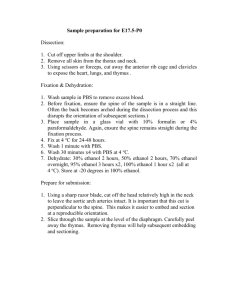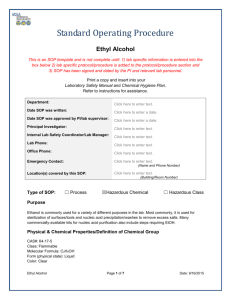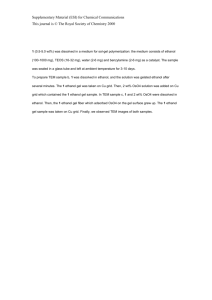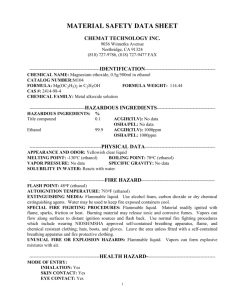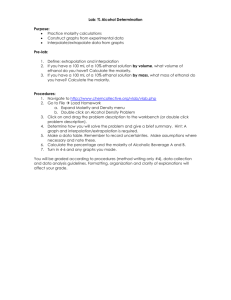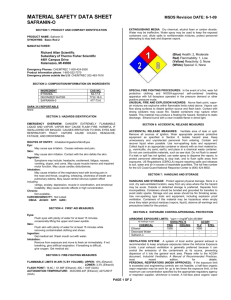Ethanol - Texas Tech University Departments
advertisement
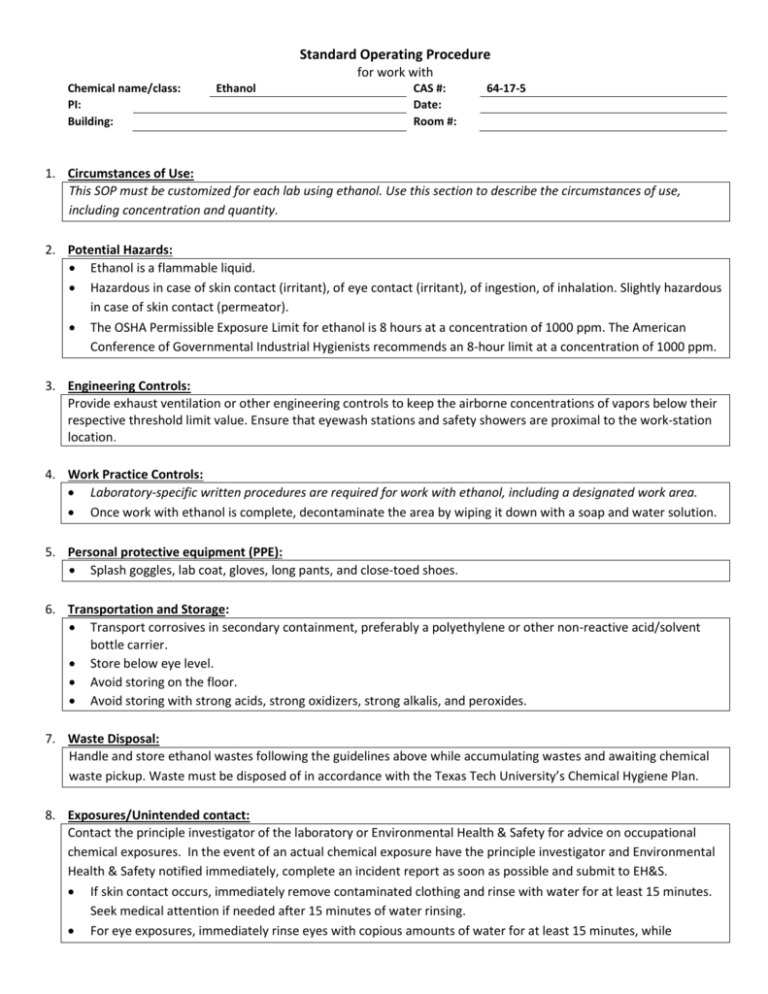
Standard Operating Procedure for work with Chemical name/class: PI: Building: Ethanol CAS #: Date: Room #: 64-17-5 1. Circumstances of Use: This SOP must be customized for each lab using ethanol. Use this section to describe the circumstances of use, including concentration and quantity. 2. Potential Hazards: Ethanol is a flammable liquid. Hazardous in case of skin contact (irritant), of eye contact (irritant), of ingestion, of inhalation. Slightly hazardous in case of skin contact (permeator). The OSHA Permissible Exposure Limit for ethanol is 8 hours at a concentration of 1000 ppm. The American Conference of Governmental Industrial Hygienists recommends an 8-hour limit at a concentration of 1000 ppm. 3. Engineering Controls: Provide exhaust ventilation or other engineering controls to keep the airborne concentrations of vapors below their respective threshold limit value. Ensure that eyewash stations and safety showers are proximal to the work-station location. 4. Work Practice Controls: Laboratory-specific written procedures are required for work with ethanol, including a designated work area. Once work with ethanol is complete, decontaminate the area by wiping it down with a soap and water solution. 5. Personal protective equipment (PPE): Splash goggles, lab coat, gloves, long pants, and close-toed shoes. 6. Transportation and Storage: Transport corrosives in secondary containment, preferably a polyethylene or other non-reactive acid/solvent bottle carrier. Store below eye level. Avoid storing on the floor. Avoid storing with strong acids, strong oxidizers, strong alkalis, and peroxides. 7. Waste Disposal: Handle and store ethanol wastes following the guidelines above while accumulating wastes and awaiting chemical waste pickup. Waste must be disposed of in accordance with the Texas Tech University’s Chemical Hygiene Plan. 8. Exposures/Unintended contact: Contact the principle investigator of the laboratory or Environmental Health & Safety for advice on occupational chemical exposures. In the event of an actual chemical exposure have the principle investigator and Environmental Health & Safety notified immediately, complete an incident report as soon as possible and submit to EH&S. If skin contact occurs, immediately remove contaminated clothing and rinse with water for at least 15 minutes. Seek medical attention if needed after 15 minutes of water rinsing. For eye exposures, immediately rinse eyes with copious amounts of water for at least 15 minutes, while occasionally lifting upper and lower lids, then promptly seek medical attention. If large amounts of vapors are inhaled, move person to fresh air immediately and seek medical attention. If ethanol is ingested, seek medical attention immediately. 9. Spill Procedure: On Texas Tech University campus, “large” spills of hazardous materials and all mercury spills must be referred to Environmental Health & Safety at 742-3876. In case of a small spill, don appropriate PPE. Keep away from heat. Keep away from sources of ignition. Stop leak if without risk. Dilute with water and mop up, or absorb with an inert dry material and place in an appropriate waste disposal container. Prevent entry into sewers or confined areas; dike if needed. If at any time the individual does not feel comfortable in cleaning up the spill they need to contact Environmental Health & Safety at 742-3876. 10. Training of personnel: All personnel are required to complete the online Lab Safety Training through the Texas Tech University Environmental Health & Safety website or attend a Laboratory Safety Seminar presented by Texas Tech University Environmental Health & Safety. These trainings include an introduction to general chemical safety. Furthermore, all personnel shall read and fully adhere to this SOP when handling the chemical. “I have read and understand this SOP. I agree to fully adhere to its requirements.” Last (print) First (print) TTU R Number Signature



